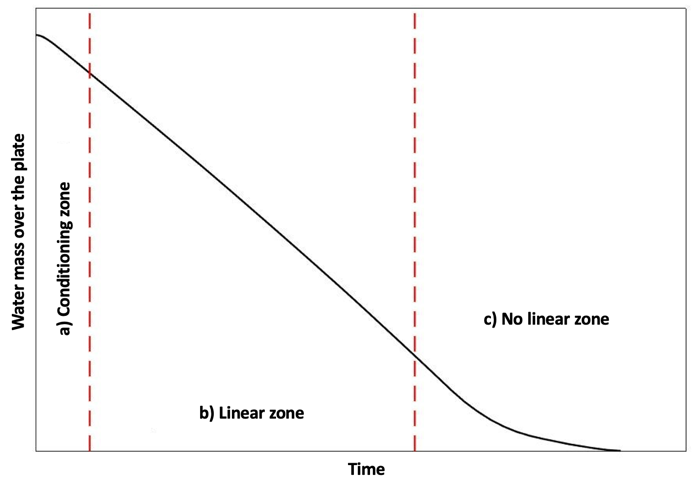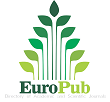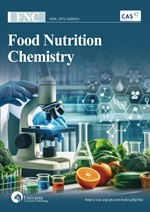Effect of temperature on water evaporation coefficient (E) in a thermobalance: A solar-driven steam generation approach
DOI:
https://doi.org/10.18686/cest.v2i3.188Keywords:
evaporation; water; temperature; moisture analyzer; steam; generationAbstract
During this investigation, the variation of the water evaporation phenomenon with the defined drying temperature and mass of water was analyzed, five levels were studied (50, 60, 70, 80 and 90 ℃), finally a correlation between temperature and evaporation rate was generated. With the study carried out, it was defined that the water evaporation velocity can be calculated with an initial mass of 35 g at 90 ℃, while the necessary time for the determination was 120 min. In addition, it was determined that the evaporation velocity follows a quadratic behavior with temperature, according to the experiments carried out with the Sartorius MA-100 balance, while the maximum deviation recorded was 0.349 mmol/m2s for a temperature of 80 ℃. It is concluded that the determination of the water evaporation velocity is highly dependent on the temperature and mass of water. Furthermore, this study can be used as a basis for future studies aimed at improving the efficiency of processes such as steam and electricity cogeneration.

Downloads
Published
How to Cite
Issue
Section
License
Copyright (c) 2024 Carlos Enrique Rojas-Sánchez, Rodolfo Antonio Hernández-Chaverri

This work is licensed under a Creative Commons Attribution 4.0 International License.
References
1. Li X, Xie W, Zhu J. Interfacial solar steam/vapor generation for heating and cooling. Advanced Science. 2022; 9(6): e2104181. doi: 10.1002/advs.202104181 DOI: https://doi.org/10.1002/advs.202104181
2. Ren J, Ding Y, Gong J, et al. Simultaneous Solar‐driven Steam and Electricity Generation by Cost‐effective, Easy Scale‐up MnO2‐based Flexible Membranes. Energy & Environmental Materials. 2023; 6(3): e12376. doi: 10.1002/eem2.12376 DOI: https://doi.org/10.1002/eem2.12376
3. Huang L, Wang Y, He R, et al. Solar-driven co-generation of electricity and water by evaporation cooling. Desalination. 2020; 488: 114533. doi: 10.1016/j.desal.2020.114533 DOI: https://doi.org/10.1016/j.desal.2020.114533
4. Xu Y, Dong S, Sheng Y, et al. Highly efficient solar driven cogeneration of freshwater and electricity. Journal of Materials Chemistry A. 2023; 11(4): 1866-1876. doi: 10.1039/D2TA08590A DOI: https://doi.org/10.1039/D2TA08590A
5. Li X, Cooper T, Xie W, Hsu PC. Design and utilization of infrared light for interfacial solar water purification. ACS Energy Letters. 2021; 6(8): 2645-2657. doi: 10.1021/acsenergylett.1c00869 DOI: https://doi.org/10.1021/acsenergylett.1c00869
6. Xie Z, Duo Y, Lin Z, et al. The rise of 2D photothermal materials beyond graphene for clean water production. Advanced Science. 2020; 7(5): 1902236. doi: 10.1002/advs.201902236 DOI: https://doi.org/10.1002/advs.201902236
7. Li Z, Ma X, Chen D, et al. Polyaniline‐coated MOFs nanorod arrays for efficient evaporation‐driven electricity generation and solar steam desalination. Advanced Science. 2021; 8(7): 2004552. doi: 10.1002/advs.202004552 DOI: https://doi.org/10.1002/advs.202004552
8. Alvarez PJJ, Chan CK, Elimelech M, et al. Emerging opportunities for nanotechnology to enhance water security. Nature nanotechnology. 2018; 13(8): 634-641. doi: 10.1038/s41565-018-0203-2 DOI: https://doi.org/10.1038/s41565-018-0203-2
9. Wang G, Fu Y, Ma X, et al. Reusable reduced graphene oxide based double-layer system modified by polyethylenimine for solar steam generation. Carbon. 2017; 114: 117-124. doi: 10.1016/j.carbon.2016.11.071 DOI: https://doi.org/10.1016/j.carbon.2016.11.071
10. Rezaie K, Mehrpooya M, Delpisheh M, et al. Solar-driven chemisorption cogeneration system integrated with thermal energy storage. Journal of Energy Storage. 2024; 76: 109705. doi: 10.1016/j.est.2023.109705 DOI: https://doi.org/10.1016/j.est.2023.109705
11. Bai H, Zhao T, Cao M. Interfacial solar evaporation for water production: from structure design to reliable performance. Molecular Systems Design & Engineering. 2020; 5(2): 419-432. doi: 10.1039/C9ME00166B DOI: https://doi.org/10.1039/C9ME00166B
12. Dao VD, Choi HS. Carbon‐based sunlight absorbers in solar‐driven steam generation devices. Global Challenges. 2018; 2(2): 1700094. doi: 10.1002/gch2.201700094 DOI: https://doi.org/10.1002/gch2.201700094
13. Ghasemi H, Ni G, Marconnet AM, et al. Solar steam generation by heat localization. Nature Communications. 2014; 5(1): 4449. doi: 10.1038/ncomms5449 DOI: https://doi.org/10.1038/ncomms5449
14. Carrier O, Shahidzadeh-Bonn N, Zargar R, et al. Evaporation of water: evaporation rate and collective effects. Journal of Fluid Mechanics. 2016; 798: 774-786. doi: 10.1017/jfm.2016.356 DOI: https://doi.org/10.1017/jfm.2016.356
15. Eames IW, Marr NJ, Sabir H. The evaporation coefficient of water: A review. International Journal of Heat and Mass Transfer. 1997; 40(12): 2963-2973. doi: 10.1016/S0017-9310(96)00339-0 DOI: https://doi.org/10.1016/S0017-9310(96)00339-0
16. Heymes F, Aprin L, Bony A, et al. An experimental investigation of evaporation rates for different volatile organic compounds. Process Safety Progress. 2013; 32(2): 193-198. doi: 10.1002/prs.11566 DOI: https://doi.org/10.1002/prs.11566
17. Manzur A, Cardoso J. Water evaporation rate (Spanish). Revista Mexicana de Física E. 2015; 61(1): 31-34.
18. Sartori E. A critical review on equations employed for the calculation of the evaporation rate from free water surfaces. Solar Energy. 2000; 68(1): 77-89. doi: 10.1016/S0038-092X(99)00054-7 DOI: https://doi.org/10.1016/S0038-092X(99)00054-7
19. Tang R, Etzion Y. Comparative studies on the water evaporation rate from a wetted surface and that from a free water surface. Building and Environment. 2004; 39(1): 77-86. doi: 10.1016/j.buildenv.2003.07.007 DOI: https://doi.org/10.1016/j.buildenv.2003.07.007
20. Turza R, Füri BB. Experimental measurements of the water evaporation rate of a physical model. Slovak Journal of Civil Engineering. 2017; 25(1): 19-23. doi: 10.1515/sjce-2017-0003 DOI: https://doi.org/10.1515/sjce-2017-0003
21. Örvös M, Szabó V, Poós T. Rate of evaporation from the free surface of a heated liquid. Journal of Applied Mechanics and Technical Physics. 2016; 57: 1108-1117. doi: 10.1134/S0021894416060195 DOI: https://doi.org/10.1134/S0021894416060195
22. Varju E, Poós T. Determination of evaporation rate at free water surface. In: Proceedings of the 8th International Symposium on Exploitation of Renewable Energy Resources and Efficiency (EXPRES 2016); Szabadka, Szerbia.
23. Chiavazzo E, Morciano M, Viglino F, et al. Passive solar high-yield seawater desalination by modular and low-cost distillation. Nature Sustainability. 2018; 1(12): 763-772. doi: 10.1038/s41893-018-0186-x DOI: https://doi.org/10.1038/s41893-018-0186-x
24. Wang W, Shi Y, Zhang C, et al. Simultaneous production of fresh water and electricity via multistage solar photovoltaic membrane distillation. Nature Communications. 2019; 10(1): 3012. doi: 10.1038/s41467-019-10817-6 DOI: https://doi.org/10.1038/s41467-019-10817-6
25. Xu Z, Zhang L, Zhao L, et al. Ultrahigh-efficiency desalination via a thermally-localized multistage solar still. Energy & Environmental Science. 2020; 13(3): 830-839. doi: 10.1039/C9EE04122B DOI: https://doi.org/10.1039/C9EE04122B
26. Yang L, Sun T, Tang J, et al. Photovoltaic-multistage desalination of hypersaline waters for simultaneous electricity, water and salt harvesting via automatic rinsing. Nano Energy. 2021; 87: 106163. doi: 10.1016/j.nanoen.2021.106163 DOI: https://doi.org/10.1016/j.nanoen.2021.106163
27. Neumann O, Feronti C, Neumann AD, et al. Compact solar autoclave based on steam generation using broadband light-harvesting nanoparticles. Proceedings of the National Academy of Sciences. 2013; 110(29): 11677-11681. doi: 10.1073/pnas.1310131110 DOI: https://doi.org/10.1073/pnas.1310131110
28. Zhang Y, Zhao D, Yu F, et al. Floating rGO-based black membranes for solar driven sterilization. Nanoscale. 2017; 9(48): 19384-19389. doi: 10.1039/C7NR06861A DOI: https://doi.org/10.1039/C7NR06861A
29. Chang C, Tao P, Xu J, et al. High-efficiency superheated steam generation for portable sterilization under ambient pressure and low solar flux. ACS Applied Materials & Interfaces. 2019; 11(20): 18466-18474. doi: 10.1021/acsami.9b04535 DOI: https://doi.org/10.1021/acsami.9b04535
30. Li J, Du M, Lv G, et al. Interfacial solar steam generation enables fast‐responsive, energy‐efficient, and low‐cost off‐grid sterilization. Advanced Materials. 2018; 30(49): e1805159. doi: 10.1002/adma.201805159 DOI: https://doi.org/10.1002/adma.201805159
31. Wang Z, Xu L, Liu D, et al. Effects of air temperature and humidity on the kinetics of sludge drying at low temperatures. Energies. 2021; 14(22): 7722. doi: 10.3390/en14227722 DOI: https://doi.org/10.3390/en14227722
32. Finnerty CTK, Menon AK, Conway KM, et al. Interfacial solar evaporation by a 3D graphene oxide stalk for highly concentrated brine treatment. Environmental Science & Technology. 2021; 55(22): 15435-15445. doi: 10.1021/acs.est.1c04010 DOI: https://doi.org/10.1021/acs.est.1c04010
33. Li X, Li J, Lu J, et al. Enhancement of interfacial solar vapor generation by environmental energy. Joule. 2018; 2(7): 1331-1338. doi: 10.1016/j.joule.2018.04.004 DOI: https://doi.org/10.1016/j.joule.2018.04.004
34. Xu X, Ozden S, Bizmark N, et al. A bioinspired elastic hydrogel for solar‐driven water purification. Advanced Materials. 2021; 33(18): 2007833. doi: 10.1002/adma.202007833 DOI: https://doi.org/10.1002/adma.202007833
35. Feistel R, Hellmuth O. Thermodynamics of Evaporation from the Ocean Surface. Atmosphere. 2023; 14(3): 560. doi: 10.3390/atmos14030560 DOI: https://doi.org/10.3390/atmos14030560
36. Venegas RM, Acevedo J, Treml EA. Three decades of ocean warming impacts on marine ecosystems: A review and perspective. Deep Sea Research Part II: Topical Studies in Oceanography, 2023, 212: 105318. doi: 10.1016/j.dsr2.2023.105318 DOI: https://doi.org/10.1016/j.dsr2.2023.105318
37. Garcia-Soto C, Cheng L, Caesar L, et al. An overview of ocean climate change indicators: Sea surface temperature, ocean heat content, ocean pH, dissolved oxygen concentration, arctic sea ice extent, thickness and volume, sea level and strength of the AMOC (Atlantic Meridional Overturning Circulation). Frontiers in Marine Science. 2021; 8: 642372. doi: 10.3389/fmars.2021.642372 DOI: https://doi.org/10.3389/fmars.2021.642372
38. Djellabi R, Noureen L, Dao VD, et al. Recent advances and challenges of emerging solar-driven steam and the contribution of photocatalytic effect. Chemical Engineering Journal. 2022; 431: 134024. doi: 10.1016/j.cej.2021.134024 DOI: https://doi.org/10.1016/j.cej.2021.134024




.jpg)
.jpg)

